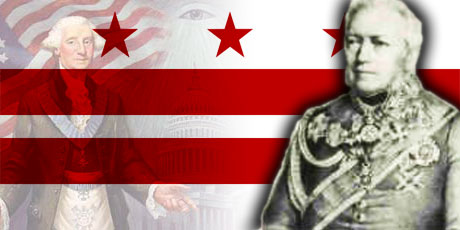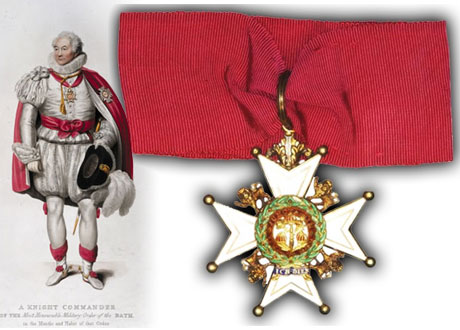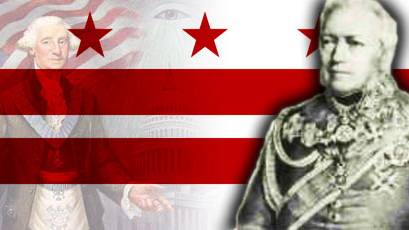George Washington’s German "Cousin"
Source: geocities.com

Writing from Berlin, James Washington had offered to fight on the side of the United States in its undeclared war against France. James, who was born in the Hague, had earlier fought against the French when they had invaded his country. General Washington, who had recently been called out of retirement because of the French crisis, unfortunately couldn’t offer a commission to his 21-year-old kinsman; the young man lacked the particular experience needed by the American Army.
George Washington had assumed correctly that he and James shared a common English ancestry. They were both descendants of the Washington family that had lived in the north of England since the 12th century. Sir Robert de Washington (died 1324) founded the Sulgrave Manor branch of the family, one of whom emigrated to Virginia in 1657 and was the ancestor of George Washington. Robert’s brother, Sir John de Washington (died 1331), founded the Hallhead Hall/Adwick-le-Street branch, one of whom emigrated to Holland around the same time and was the ancestor of James Washington.
Instead of the U.S. Army, James Washington joined the Bavarian Army. In 1807 Jakob Washington, as he was known in Germany, was chosen by the Crown Prince of Bavaria, the later King Ludwig I, to be one of his military adjutants. As such he accompanied Ludwig to the peace negotiations with Napoleon at Tilsit, East Prussia, in 1807, where Prussia lost half its subjects. As marshal of Ludwig’s court, Washington accompanied the crown prince to the Congress of Vienna (1814–15) where the victorious Allies restored the old order to Europe. After Napoleon returned from exile in Elba in 1815, Colonel Washington signed a treaty in Brussels with the Duke of Wellington on behalf of Bavaria; through this treaty Great Britain agreed to subsidize the Bavarian Army in the renewed war against Bonaparte. Eleven days later, Washington took part in the Battle of Waterloo by the side of Wellington, who was often in the thick of the action. Bavarian troops also participated in this battle on the side of the Allies.
Baron von Washington
In 1830, Washington was raised to the rank of hereditary baron by King Ludwig I. Now known as Jakob Freiherr von Washington, he chose as his baronial coat of arms the ancient markings of his family; these three red stars and two red stripes horizontal on a field of silver are familiar to Americans as the flag of the District of Columbia. Baron von Washington used as his motto the same as that of the first American President, EXITUS ACTA PROBAT (Judge a deed by its results). Jakob was justly proud of his relationship to George Washington and displayed portraits of the great American in his residencies. At the same time he conscientiously attended his monarch Ludwig, who became known for three things: He founded the Oktoberfest, which started as the celebration of his wedding to a Saxon princess. He adopted the mountaineers’ Lederhosen and made them fashionable. He turned his capital of Munich into one of the stateliest cities in the world.
Washington’s Bavarian Castle
When after the death of his first wife, the Baron married the Baroness Caroline in 1833, he acquired her home, the medieval Castle or Schloß Notzing near Munich. Promoted to lieutenant general—the same rank held by George Washington—he returned to the mother country of his family in 1843 to be made Knight Commander of the Order of the Bath by Queen Victoria. A portrait shows him wearing no less than 11 stars or crosses on his general’s uniform. Washington’s career culminated as adjutant general of the King of Bavaria. He died in 1848 at the age of 70, only 16 days after Ludwig I, whom he had so faithfully served, was forced to abdicate because of his affair with the dancer Lola Montez.

Knight Commander of the Bath. Image from: virtualmuseum.info & Badge of a Companion of the Order of the Bath (Military Division
Stars and Stripes on Bavarian Tombstones
General von Washington is buried with his wife and one son in the village church of Notzing, which is about 25 kilometers northeast of the Bavarian capital. The Washington family sepulcher is incorporated into the walls of this Gothic church dating from about 1450; their memorial stones are attached to its outside walls, next to the main entrance. On these stones are carved the Washington stars and stripes. A silver dollar’s throw away is Schloß Notzing. In 1945–46 American soldiers lived in the home once owned by George Washington’s German "cousin."
By Gary C. Grassl, with thanks to Herr Georg Gruber, Archivpfleger of Notzing
Article from: http://www.geocities.com/Athens/
Thebes/8171/GeorgeWashington.html






















